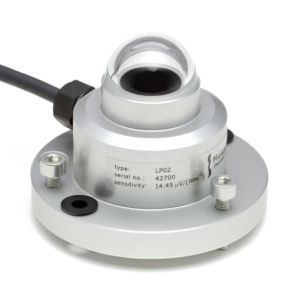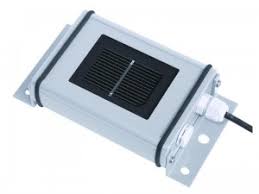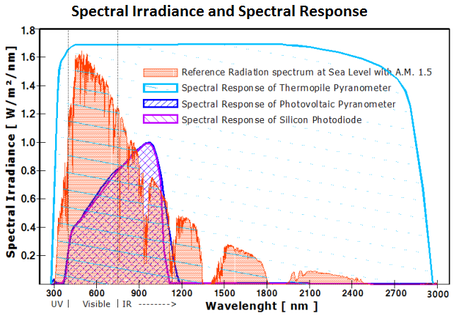When we want to forecast production or calculate PR, the first question we ask when we are presented with data is the source of that data. Did you take it from the pyranometer or from the reference cell?
They both measure radiation. Only one is more sensitive and more expensive. Then he’s good, right?
Not 🙂
Pyranometer:

Pyranometers measure radiation by measuring the change in temperature difference between the black surface and the surface below it. In other words, the measurement point is the temperature measurement. The temperature change is also converted into radiation.
Reference Cell:

Reference cells are small solar panels. Like other solar panels, they start producing energy when they see light. We measure the radiation by measuring the short-circuit current of the reference cell.
So what are the differences between the two?
First of all, the light spectra they measure are different.

As you can see in the graph above, the spectrum of the light blue colored pyranometer is much wider than the spectrum of the photovoltaic cells shown in pink. The measurement range is therefore very wide.
Pyranometers, unlike reference cells, measure temperature, so the transmittance of the glass has no effect (and their effect on shape is minimal). However, since flat glass is used in reference cells, the reflection of light on the glass surface varies for each different angle and is therefore subject to IAM (Incidence Angle Modifier).
In terms of uncertainty, pyranometers are much better, but the reaction time of reference cells is faster.
So which product should be used to calculate PR correctly? Reference cells. ‘How?’ I hear you say.
Reference cells give similar reactions when silicon-based solar panels are used. Therefore, any variation in the facility can be easily determined. In addition, since the technology used is the same, the uncertainty will be lower (the response of the pyranometers to diffuse may not be the same as the response of the reference cells). The conversion of pyranometers placed horizontally on the plane into energy that can be used by solar panels will lead to mathematical operations. These mathematical operations will also increase the uncertainty. Our aim is to minimize measurement uncertainties.
At this stage, pyranometers stand out; comparison with the irradiance value calculated before the start of the investment. The irradiance databases that we rely on before starting the investment are measurements that include the entire spectrum. To calculate the deviation from these measurements, a pyranometer must be used in the horizontal plane. By comparing the assumed irradiance with the actual irradiance, the deviation in the model can be determined and the expected/actualized production analysis can be done more accurately by correlating the energy output with the reference cell (‘Why doesn’t this one produce this?’ syndrome). At this stage, it is not known how many companies working in detail like us can really calculate and compare in this detail.
When it comes to calculating the PR of the facility, the reference cell will give more accurate results. So, is only one reference cell sufficient? We recommend one reference cell for each transformer station. Data loss and calibration drift between reference cells can be a problem in later years.
An accurate PR calculation can be realized by compiling all this data in a healthy way.
Note: Even if you make an accurate measurement, if you use a monitoring/scada system that cannot take healthy measurements, every detail described above loses its meaning. There is no saving from the data monitoring system. Take care to work with proper companies.